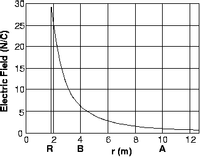Question
Carefully study the following plot of electric field E in N/C versus distance r in m and answer the questions that follow. The electric field is directed radially outward, and the variation of E with r is independent of direction.
Referring to the figure above, determine the work done by the electric field on a 2.6μ C charge moved from A to B.

Transcribed Image Text:6
8
12
R
r (m)
2.
5
Electric Field (N/C)
Expert Solution
This question has been solved!
Explore an expertly crafted, step-by-step solution for a thorough understanding of key concepts.
This is a popular solution
Trending nowThis is a popular solution!
Step by stepSolved in 5 steps with 5 images

Knowledge Booster
Similar questions
- Please answer the following question(s): 1. When a battery is connected to a capacitor (device that stores charge) the charge q builds up -t according to the equation q = q (1-e ¹), where do is the maximum charge and ī is a constant. At what time t does the charge reach 10% of its maximum value? (Note: Enter your answer in terms of tau, ī, using the Greek letters in MathType.) √ S t10% =arrow_forwardCarefully study the following plot of electric field E in N/C versus distance r in m and answer the questions that follow. The electric field is directed radially outward, and the variation of E with r is independent of direction. Referring to the figure above, determine the work done by the electric field on a 4.1μ C charge moved from A to B. For my answer I got 4.1*10-5 J which was wrongarrow_forwardThree (3) point charges with q = 7.50 uC are initially held fixed as shown in the figure. The charges are then released, and all three move in response to the electric force between them. Assuming L = 250m, what is the sum of the kinetic energies of the three particles when they are very far apart? Show your work and use significant figures in the final answer. [ Answer: 3.87 J ]arrow_forward
- Please solve subparts A,B,C max 30 minutes pleaase and send here. Thank u Two charges of +Q each are placed x = a and x = - a A. Determine the electric field at the point (0,y) B. A small object with mass m and charge q can move freely along the y axis. Determine the force experienced by the object if the object is initially at (0,y) C. Determine the type of object in such a way that the force experienced by the object always has direction to the origin (0,0)arrow_forwardℓ = 9 cm, and Q = 3 μ C. Calculate the potential energy of the right-side charge, in Joules. Please be careful of units. If you blow off units, you will get a wrong answer, and the system will count it wrong. Diagram is attached.arrow_forwardYou Answered Correct Answer A line of charge is placed along the negative x axis from x=-0.4m to x=0. The charge is uniformly distributed with linear charge density 3.06pC/m. A proton is released from rest at a point on the positive x axis 2.53m. When the proton has a speed of 472.1m/s, how far will it have moved (in m}? 1.0975 margin of error +/-1%arrow_forward
- Electrostatic forces are conservative. This means that mechanical energy (KE +PE) is constant or conserved in absence of other dissipative forces such as friction. If a charged particle moves from point A to point B in an electric field (assume that dissipative forces such as friction are absent), select all the statements that are true. The symbol A represents the change in the particular quantity. Recall what does positive and negative work mean? Reflect on what the negative sign represents in each case? Select multiple answers. APE=-Work A→B i.e., for positive work, PE decreases and for negative work, PE increases ΔΚΕ # -ΔΡΕ ✓ changes in KE and PE are not connected. ΔΚΕ = -ΔΡΕ i.e., if KE increases, PE decreases and vice-versa APE=WorkAB Ⓒi.e., for positive work, PE increases and for negative work, PE decreasesarrow_forwardb and c pleasearrow_forwardQuestion 6 and 7. Index to show all work said assume that R = 2.43 m and c = 1.47 nC/m^4 the total charge of the diskarrow_forward
arrow_back_ios
arrow_forward_ios